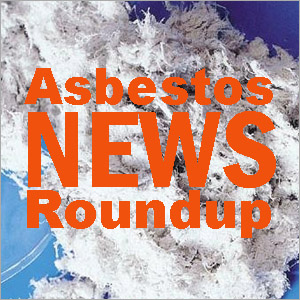Asbestos News Roundup: 7.9.10
July 9th, 2010. By LucyC
A roundup of recent asbestos-related news and information that you should be aware of.
Asbestos Lawsuits
St. Clair County, IL: Another asbestos lawsuit was filed in St. Clair County this week, by Donna Stinson of Virginia. It is the 15th asbestos lawsuit of the year in St. Clair County Circuit Court.
Mrs. Stinson has named 98 companies as defendants in her lawsuit, which alleges that they caused her recently deceased husband, Gerald P. Stinson, to develop lung cancer after his exposure to asbestos-containing products throughout his career as a boilermaker from 1963 until 2001.
As a result of his asbestos-related diseases, the suit claims, Mr. Stinson became disabled and disfigured, incurred medical costs and suffered great physical pain and mental anguish. Furthermore, the illnesses prevented him from pursuing his normal course of employment and, as a result, he lost large sums of money that would have accrued to him.
The suit claims that the defendants should have known of the harmful effects of asbestos, but failed to exercise reasonable care and caution for the plaintiffs’ or their deceased relative’s safety, the suit states. (madison.com)
Asbestos Hot Spots
Narragansett, RI: Asbestos has been round in roof panels of the changing rooms at the North Pavilion bathouse in Narragansett, RI. As a result, the pavilion has been closed to the public while workers remove the asbestos-containing material—a job made all the more urgent as a result of the current extreme heat the East coast is experiencing.
According to local news reports, the Narragansett bathhouse pavilion is at least 50 years old, meaning it was constructed at a time when asbestos was commonly used on building materials, without much knowledge of the health consequences. Because asbestos exposure can lead to fatal chronic illness such as asbestos mesothelioma, the town of Narragansett is currently on a mission to remove all asbestos from any establishments in the town. This process is expected to more than a couple of years. (huliq.com)
The Jeffrey Asbestos Mine Debacle
Montreal, PQ: French Canadians heard the voices of international protestors this week, as people and organizations from around the world petitioned the Canadian and Quebec governments to stop the multi-million dollar funding that would keep a Jeffrey asbestos mine afloat for another quarter of a century.
The asbestos is exported to developing countries in Asia, as well as the United States, so protesters gathered in Seoul, Korea, and outside the Canadian Consulate in Hong Kong, calling for a complete ban on asbestos imports from Quebec to Asia. The timing of the protest was no accident, as it coincided with Quebec’s provincial holiday, St. Jean Baptiste Day.
According to the Montreal Gazette, “the Quebec government stands poised to approve a $58 million loan guarantee to help finance expansion of the Jeffrey Mine at Asbestos, Que. The new underground operation would generate about 200,000 tonnes of asbestos per year starting in 2012, most of which would be exported.”
Currently, Hong Kong is experiencing an asbestos disease epidemic, according to news release by the Asia Monitor Resource Centre, a labor organization based in Hong Kong. “Many workers continue to die every year due to lung cancers and mesothelioma—a deadly lung cancer caused by exposure to asbestos. (Montreal Gazette)
Adding their voices to the growing number of people protesting the continued funding of the Jeffrey Asbestos mine, is a multinational group of doctors and other health care professionals. In their recently released statement they condemned world leaders for their reluctance to institute bans on the mining, manufacture and sale of asbestos, in complete disregard of the scientific evidence which supports such a ban.
While many nations have banned asbestos, Canada is one of the few remaining industrialized nations that so far refuses to do so. The Canadian government’s reasoning rests in part on an assessment that says chrysotile asbestos may be less dangerous to human health than other types of asbestos. However, the international medical community’s response to this is that this conclusion has not been scientifically substantiated. In their statement, published in Environmental Health Perspectives, the doctors also say that decades of clinical studies and experiments have shown that chrysotile is no safer than any other form of the mineral and calls the idea of safe, controlled use the substance “a fallacy”. (mesothelioma.com)
-
Leave a Reply
Archive by Category
- Accidents (24)
- Airlines (9)
- Asbestos Mesothelioma (262)
- Automotive (25)
- Celebrity (14)
- Class Action (84)
- Complaints/Comments (15)
- Consumer Fraud (84)
- Contest (2)
- Court of Public Opinion (5)
- Crazy Sh*t Lawyers See (61)
- Criminal Law (4)
- Defective Products (111)
- DePuy ASR Hip Recall (2)
- Discrimination (22)
- Drugs/Medical (248)
- Elder Care Abuse (4)
- Emerging Issues (462)
- Employment (54)
- Environment (52)
- Financial (28)
- Food Illness (15)
- Human/Civil Rights (4)
- Insecurities (5)
- Insurance (16)
- Intellectual Property (16)
- Internet/E-commerce (19)
- lawsuits (161)
- Lawyers (20)
- Lawyers Giving Back (43)
- Lex Levity (10)
- Personal Injury (106)
- Pleading Ignorance (53)
- Real Estate (2)
- Recall (6)
- Scam (3)
- Securities (13)
- Settlement (81)
- Tort Reform (2)
- Totally Tortelicious (81)
- Veterans (11)
- Whistleblower (9)